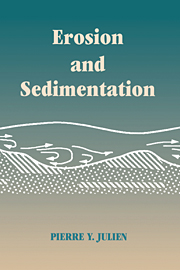Book contents
- Frontmatter
- Contents
- Preface
- Notation
- 1 Introduction to erosion and sedimentation
- 2 Physical properties and dimensional analysis
- 3 Mechanics of sediment-laden flows
- 4 Particle motion in inviscid fluids
- 5 Particle motion in Newtonian fluids
- 6 Turbulent velocity profiles
- 7 Incipient motion
- 8 Bedforms
- 9 Bedload
- 10 Suspended load
- 11 Total load
- 12 Reservoir sedimentation
- Appendix: Einstein's sediment transport method
- Bibliography
- Index
1 - Introduction to erosion and sedimentation
Published online by Cambridge University Press: 05 June 2012
- Frontmatter
- Contents
- Preface
- Notation
- 1 Introduction to erosion and sedimentation
- 2 Physical properties and dimensional analysis
- 3 Mechanics of sediment-laden flows
- 4 Particle motion in inviscid fluids
- 5 Particle motion in Newtonian fluids
- 6 Turbulent velocity profiles
- 7 Incipient motion
- 8 Bedforms
- 9 Bedload
- 10 Suspended load
- 11 Total load
- 12 Reservoir sedimentation
- Appendix: Einstein's sediment transport method
- Bibliography
- Index
Summary
Erosion and sedimentation embody the processes of erosion, transportation, and deposition of solid particles, often called sediments. These natural processes have been active throughout geological time and have shaped the present landscape of our world. Today, erosion, transport, and sedimentation can cause severe engineering and environmental problems.
Human activities exert a profound influence on erosion. Under some circumstances, the erosion rate is 100 times greater than the normal, or geological, erosion rate. The erodibility of natural materials is enhanced by disturbances to the soil structure due to plowing and tillage. The protective canopy is weakened by grubbing, cutting, or burning of existing vegetation. Besides producing harmful sediment, erosion may cause serious on-site damage to agricultural land by reducing the fertility and productivity of soils. Runoff conditions on land surfaces and the hydraulic characteristics of flow in channels are exacerbated by improvements in surface drainage and by alterations in the characteristics of natural channels such as meander cutoffs.
Severe erosion can occur during the construction of roads and highways when protective vegetation is removed and steeply sloping cuts and fills are left unprotected. Such erosion can cause local scour problems along with serious sedimentation downstream. Approximately 85% of the 571,000 bridges in the United States are built over waterways. The majority of these bridges span rivers and streams that are continuously adjusting their beds and banks. Bridges on more active streams can be expected to experience scour problems as a result of stream realignment.
- Type
- Chapter
- Information
- Erosion and Sedimentation , pp. 1 - 3Publisher: Cambridge University PressPrint publication year: 1995



